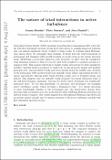The nature of triad interactions in active turbulence
Author(s)
Slomka, Jonasz Jozef; Suwara, Piotr; Dunkel, Joern
Download1708.01394.pdf (2.761Mb)
OPEN_ACCESS_POLICY
Open Access Policy
Creative Commons Attribution-Noncommercial-Share Alike
Terms of use
Metadata
Show full item recordAbstract
Generalised Navier-Stokes (GNS) equations describing three-dimensional active fluids with flow-dependent narrow spectral forcing have been shown to possess numerical solutions that can sustain significant energy transfer to larger scales by realising chiral Beltrami-type chaotic flows. To rationalise these findings, we study here the triad truncations of polynomial and Gaussian GNS models focusing on modes lying in the energy injection range. Identifying a previously unknown cubic invariant for the triads, we show that their asymptotic dynamics reduces to that of a forced rigid body coupled to a particle moving in a magnetic field. This analogy allows us to classify triadic interactions by their asymptotic stability: unstable triads correspond to rigid-body forcing along the largest and smallest principal axes, whereas stable triads arise from forcing along the middle axis. Analysis of the polynomial GNS model reveals that unstable triads induce exponential growth of energy and helicity, whereas stable triads develop a limit cycle of bounded energy and helicity. This suggests that the unstable triads dominate the initial relaxation stage of the full hydrodynamic equations, whereas the stable triads determine the statistically stationary state. To test whether this hypothesis extends beyond polynomial dispersion relations, we introduce and investigate an alternative Gaussian active turbulence model. Similar to the polynomial case, the steady-state chaotic flows in the Gaussian model spontaneously accumulate non-zero mean helicity while exhibiting Beltrami statistics and upward energy transport. Our results suggest that self-sustained Beltrami-type flows and an inverse energy cascade may arise generically in the presence of flow-dependent narrow spectral forcing.
Date issued
2018-04Department
Massachusetts Institute of Technology. Department of MathematicsJournal
Journal of Fluid Mechanics
Publisher
Cambridge University Press
Citation
Słomka, Jonasz et al. “The Nature of Triad Interactions in Active Turbulence.” Journal of Fluid Mechanics 841 (February 2018): 702–731 © 2018 Cambridge University Press
Version: Original manuscript
ISSN
0022-1120
1469-7645